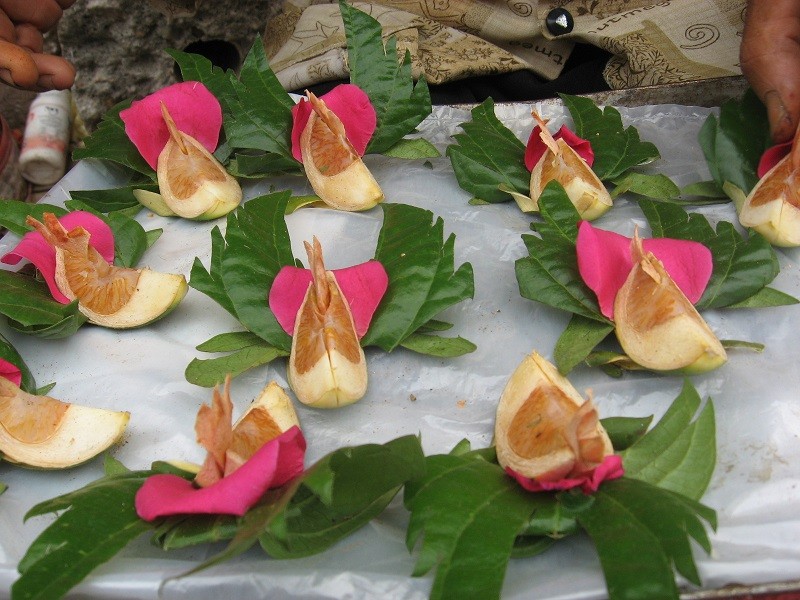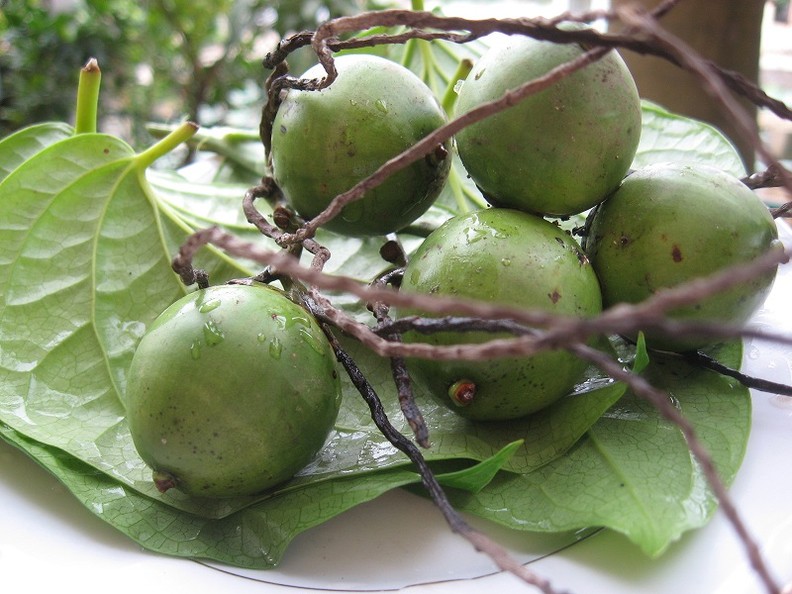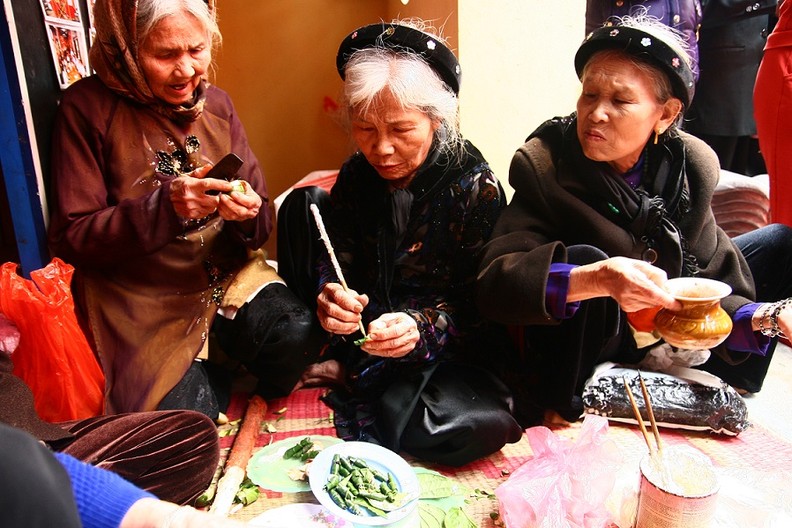Chewing a quid of betel is a long-standing tradition of Vietnamese culture, but it currently seems to be on the wane.

A quid of betel is composed of four elements, namely sweet areca, spicy betel leaf, bitter chay root, and acrid lime.
Widely known in Vietnam, trau (betel) and cau (areca) create a fine traditional trait in the Vietnamese culture. A quid of betel is composed of four elements, namely sweet areca, spicy betel leaf, bitter chay root, and acrid lime. The perfect betel should be wrapped in the shape of a “phoenix’s wing”, which reveals the skill of the person who made it.
According to the old texts, betel “not only freshens the breath but also calms bad temper and helps in digesting food”. It is said to promote a feeling of goodwill. “Every conversation begins with a quid of betel,” claims a Vietnamese proverb.
Betel was traditionally offered in celebrations like weddings and festivals, and to ease the sadness of a family in mourning. It also represents Vietnamese people’s respect for their ancestors, which is why betel and areca are often placed as offerings on ancestral altars.
Somehow, I always like a song named La Trau xanh (The fresh betel leaf) by famous old musician Vien Chau. The song tells of an inconclusive love-affair between a countryside poor girl, who sells betel and areca, and a rich man. On their village’s dyke, they promise each other a long-life love regardless of disapproval and difficulties caused by the man’s family. “I promise you my deep love, which is forever likened to the mixture of a betel quid and a sweet areca,” the young man says. “I am not afraid of the golden sunlight withering my fresh leaves, but I am afraid of you my darling awaiting me in anxiety and sadness,” the girl replies.

Trau (betel) and cau (areca) create a fine traditional trait in the Vietnamese culture.
However, standing between his love for his sweetheart and his dutifulness to his family, the man decides to break his promise with the girl to marry another rich one whom his family has proposed marriage to. The salesgirl is now left in desperate situation. Her fresh betel and arecas now have withered and dried on the dyke on which the two lovers used to be awaiting each other.
The girl’s work can be seen in many places in Vietnam. In Ho Chi Minh City, we come across the Le Quang Sung Betel Market by the Cho Lon Bus Station. In Hanoi, this image can be seen in rural markets, especially in the city centre’s Bac Qua or Long Bien markets, behind Dong Xuan Market.
80-year-old Nguyen Thi Tra, a seller of betel and areca in Cao market in Hanoi’s suburb, says that she started the business when she got married at the age of 12. “My husband’s family has engaging in trading betel and areca for six generations,” the old woman says.
“Betel and areca also have ups and downs like the human’s life,” she says. “They are luxuriant and fruit during August, September, and October of the lunar calendar. Just fifteen years ago, if weddings or festivals did not take place during these months, only dried betel and areca were available.”
She explained that to store areca for sales during other months, people used to cleave the product into sections, dry them in the sun and keep it in dried and clean places.
“But now, progress in science and technology has helped to create different types of arecas. We can have fresh arecas all the year round, not seasonally as before,” she says.
“Those who sell betel and areca are required to be of great charm. They have to know the different forms of the products to be sold for different purposes,” she says with great experience.
She explains that there are two types of areca. The first (trau nep) has a thin round large shape and the second (trau te) is thick with an oval shape.
Areca is also divided into two types. The first is called cau sung, which has shiny green skin and a shape of a ball with lots of tassels, while the second is termed cau mo qua or cau dai, which has an egg shape with green skin and few tassels.
“Trau nep and cau sung are more delicious than the rest because their flavour is warm. Cau sung has soft white flesh and a pink soft core, while cau mo qua has tough gray flesh and a hard core,” she explains.
I met a vendor selling betel and areca named Do Thu Thuy, 63, from the northern province of Hung Yen, at a corner of the Hanoi’s Bac Qua Market. She is making quids of phoenix-wing betel (trau canh phuong). Giving me a quid, she says that she has sold the product for years and considers the trade as a means of living.
Thuy says each bunch of arecas has some 100-130 units and the price for each areca in wedding season (from September to December of the lunar calendar) mount to VND5,000 (20 US cents) and in other months, the price is halved.
Betel leaves are sold in each 100-leave bunch at 40,000-45,000 VND (1.66-1.87 USD) and bars of chay root are sold at 30,000 VND (1.25 USD) per kilogramme.
“The selection of a nice-looking bunch of arecas is not so difficult but not everyone is a connoisseur,” Thuy says.
“The areca bunch for special events such as le an hoi (betrothal ceremony) or dan cuoi (bringing wedding offerings to the bride’s after le an hoi) is required to have clustered nice-looking arecas of the same size with straight tassels, one of the attractions of the bunch. If you are not a connoisseur, you may buy a good bunch but with false tassels, which are glued from broken tassels of other bunches,” she says.
“If you want to keep the fruit fresh, you should put it into lime water.”
78-year-old Nguyen Thi Vuong, another seller, says that she has to instructs buyers the ways to arrange the products on the plates and in the caskets in case of weddings or le an hoi or xin dau (action of groom’s mother carrying a small casket with some carefully-decorated betel and areca to the bride’s to ask the latter’ representatives to permit the groom to bring her home).
Vuong says that buying betel and areca means no bargains. Traditionally, Vietnamese people will buy betel and areca first when they go to the market for the first time in the New Year. The goods can be sold quickly during the morning of the first day of the lunar new year because it is considered important in bringing the first good luck of the year, all families necessarily rush out to buy the goods regardless of bargaining.
Chewing a quid of betel at leisure, Vuong confides that she is proud of having sold betel and areca for nearly 60 years. Such a long time has helped her understand the fine trait of the nation’s culture.

Chewing a quid of betel is a long-standing tradition of Vietnamese culture
However, Thuy says that she earns little money from selling the products and she cannot afford even a fixed place in the market. “We have to watch out the market guardians who try to drive off such vendors like us,” she says.
My’s betel and areca looks very beautiful. “However, unlike the past when each wedding used to need some thousands of arecas and betel leaves, people need only 100-200 arecas for each wedding because few people eat betel and areca now,” she says.
Pham Thi Mai, who owns black teeth, adds that today, people mainly enjoy assorted confectionery and drinks during festivals and betel and areca seems to be used more as a symbolic factor.
Chewing betel ground by a chay (an eight-centimetre bronze bar) and a bronze coi (mortar which is as small as a cup), Mai says: “The betel and areca culture will never fade away. When it is not used in weddings or funerals any longer, there will be no one trading it.”
In the sunshine of the afternoon, I suddenly hear the familiar lyrics, which goes:
Our love is just like an areca cleft into two sections and a green betel leaf.
When the market is over I still hear your soft warm whisper in my head.
Cong Thanh